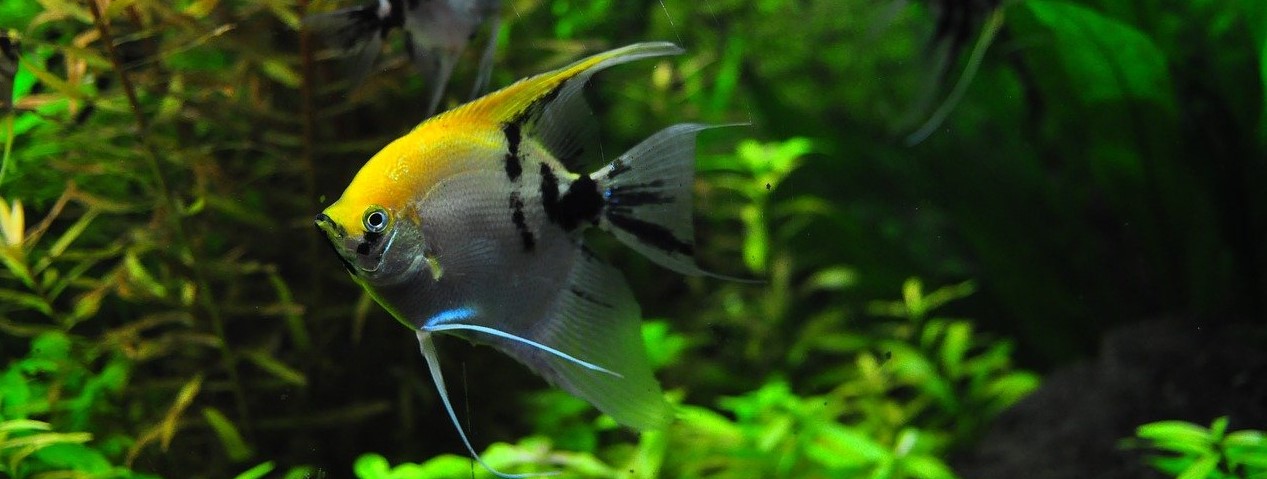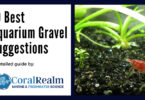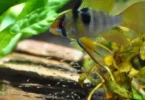Last Updated on November 19, 2022 by Matt
Along with nitrite, aquarium ammonia is incredibly toxic to your fish. Ammonia is the most toxic of the three inorganic nitrogenous compounds, ammonia, nitrite, and nitrate, found in fish tanks. They play a huge role in the nitrogen cycle.
Even when found in low concentrations in a tank it can cause ammonia poisoning in fish, which can be lethal if not treated swiftly.
In this guide to aquarium ammonia and ammonia poisoning, we will run through how ammonia is generated in the tank, before telling you about the difference between ammonia and ammonium, and how you can test for ammonia and how to reduce the concentration.
IN THIS ARTICLE
How Is Aquarium Ammonia Produced?
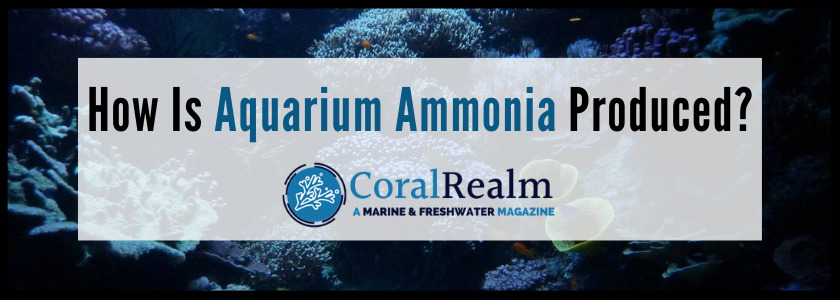
Ammonia occurs in the water column through a couple of different processes. Fish produce ammonia as a waste product during protein catabolism, in layman’s terms the breakdown of proteins into energy. This waste ammonia is excreted through the gills directly into the water column. Aquarium Ammonia is a natural part of any life aquatic process.
The other way that ammonia occurs in an aquarium is through the natural action of the nitrogen cycle. You can get full information on the aquarium nitrogen cycle by reading our full article on the subject, but we will give a brief overview here.
As organic waste, excess food, fish feces etc, decays in the tank, the bacteria which break down the waste release ammonia into the water column. This process is called mineralization. Ammonia is also created during another stage of the nitrogen cycle, called nitrogen fixation.
As you move through the steps of the nitrogen cycle, nitrifying bacteria converts ammonia to nitrite, and nitrite to nitrate. Denitrifying bacteria then convert nitrate to atmospheric nitrogen.
What is the Difference Between Ammonia and Ammonium?
This is a very good question, and one that often has aquarists a little confused. The answer lies in knowing a bit of chemistry.
Ammonia (NH3) when dissolved in water acts as a weak base and forms the positively charged ion ammonium (NH4+). Ammonium is also commonly called the ionized form of ammonia. The amount of ammonia that is converted to ammonium depends on the pH of the water; the equilibrium will change and cause either ammonia or ammonium to be produced depending on the pH.
H2O + NH3 ⇌ OH– + NH4+
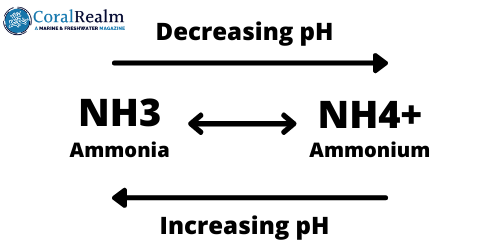
Ammonium is a source of nitrogen for plants and algae. They will draw it from the water column and be able to utilize it for their own ends. This is good in more ways than one. Not only does ammonium act as a fertilizer, but as the aquarium plants draw it from the water column, it affects the equilibrium of ammonia to ammonium. Removing ammonium means that more ammonia is converted to ammonium to replace it.
How Does pH Affect Aquarium Ammonia?
So we have said that the equilibrium of ammonia and ammonium found in aquariums is dependent on pH, but how exactly?
Well ammonia acts as a base in water. This is basically a fancy way of saying that in acidic water, the equilibrium creates way more ammonium. In alkali water, the equilibrium shifts and more ammonia is created. Water with a pH of 8 will have ammonia levels 10x higher than the exact same water with a pH of 7.
Essentially, for aquarium purposes you need to be aware that slightly acidic water will convert ammonia to ammonium, helping to relieve the stress of high ammonia levels.
It is a delicate balance however; the main genus of nitrifying bacteria which converts ammonia to nitrite, Nitrosomas, is impacted by pH levels below 6, and it’s ability to convert ammonia is lessened.
Temperature also affects the equilibrium which exists between ammonia and ammonium, but to a far lesser degree. The higher the temperature, the more ammonia is present.
What Is A Healthy Level of Aquarium Ammonia?
Hopefully the section above has cleared up the difference between ammonia and ammonium. Ammonium is not toxic to fish, unless in ridiculously high concentrations, while ammonia is highly toxic.
Unfortunately, there is no healthy level of ammonia in aquariums. Ammonia is an incredibly toxic compound to fish, and even when found in small quantities you will see the effects of ammonia poisoning.
Fish can feel the impact of aquarium ammonia even when it is as low as 0.05 ppm (mg/L). At 0.05 ppm ammonia will begin to cause gill damage, and death will occur at around 2 ppm.
While the ionized form of ammonia, ammonium, is non-toxic and won’t negatively impact your fish, it can be a silent danger. Nitrifying bacteria cannot use ammonium in their processes, and won’t change this ionized ammonia to nitrite. Plants will use it as a source of nitrogen but may not be able to use a significant portion.
So for example if you have a high level of ammonium in the water column, it will most likely stay unless something is done. If the pH of your tank suddenly rises for whatever reason, a water change, new substrate etc, then this ammonium can suddenly become ammonia and cause sudden ammonia poisoning.
Testing for Aquarium Ammonia
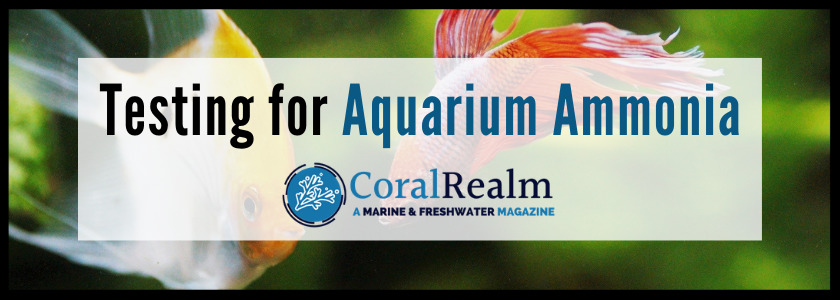
Fortunately, testing for aquarium ammonia is very easy. There are many testing kits that you can purchase that will give you a very accurate result.
It is highly recommended that you test often for aquarium ammonia. It is a silent killer and you will have no warning signs before your fish start displaying the signs of ammonia poisoning, and if not treated they will die.
- Sachem sensor Technology
- No Strips, no tests, just constant readings
- For marine and freshwater use
Using something like the Seachem Ammonia Alert can be extremely useful. It gives a constant reading, and so you can quickly check to see if your ammonia levels are at a healthy level.
Whilst the Seachem Ammonia Alert is fairly accurate, it should only be a rough guide. It isn’t there to do a full test.
Test strips and kits for ammonia are a good way of accurately measuring the ammonia levels in your tank.
There is one thing to be aware of though; most of the test strips available online test for both the toxic free ammonia and non-toxic ammonium ion. The vast majority of testing kits lump these two forms of aquarium ammonia in together, and so can give a false positive. They can show high ammonia, only for it to be high ammonium, which isn’t a cause for immediate concern.
- Seachem MultiTest Ammonia Test Kit- 75 Tests for Freshwater or Saltwater Aquariums
- ACCURATE: This kit measures total (NH3 and NH4+) and free ammonia (NH3 only) down to less than 0.05 mg/L and is virtually interference free in marine and freshwater
- 75 TESTS: MultiTest Ammonia performs over 75 tests. With the multi-cavity test plate, multiple chemical tests can be run at the same time
- COMPLETE PERFORMANCE: The kits proper performance can be validated by running a test in the normal manner except that the reference sample is used in place of aquarium or tank sample
- COLOR CHART: All MultiTest test kits come with an easy-to-read color chart. It features a 5 cm viewing window to help isolate color and match as closely as possible to the test sample
The Seachem MultiTest Ammonia Test Kit however accommodates this difference. Not only does it test for combined free ammonia and ammonium, but it also tests for free ammonia alone. This makes it incredibly useful, as you can see exactly what is going on in your tank.
Knowing the level of ionized ammonium in your tank will let you know if your tank is at risk from a pH change. If you have a high level of ammonium, a pH increase will convert it to ammonia, causing ammonia poisoning.
Reducing Ammonia in Fish Tanks
There are a number of things you can do to reduce the amount of ammonia in an aquarium. If you have discovered that the ammonia levels are reaching dangerous highs, you need to act quickly to prevent ammonia poisoning and likely fish death.
While you need to act fast, don’t panic! High ammonia levels are very dangerous, but in working to lower them you can make your aquarium a better habitat for your fish.
High Volume Water Change
Conducting a high volume water change of 50% should be your first port of call.
Undertaking a large-scale water change like this will instantly lower the ammonia level in the water column. Remember to use a good quality water conditioner on the tap water to remove any contaminants. Ideally distilled or RODI water should be used as these contain no contaminants, being only pure water.
When changing a large portion of the water like this, it is very important that the new water you use to replace the old is the same temperature. Your fish will be under high stress with the concentration of ammonia in the tank. The last thing they need is added stress due to a sudden increase or decrease in temperature. Water changes can be made easier using a product like the Python water changer.
Ammonia Removing Water Conditioner
An aquarium water conditioner such as Seachem Prime can be very useful in lowering aquarium ammonia in the short term.
Seachem Prime not only removes the heavy metals and other contaminants that are very dangerous to fish, it also binds ammonia and nitrite and makes them non-toxic. This bound ammonia is then easily used by the bacteria found in the tank.
Aquarium Bacteria Supplement
Adding a dose of aquarium bacteria supplement into the tank can help in lowering ammonia in an aquarium.
Aquarium bacteria supplements contain live nitrifying bacteria which convert ammonia to nitrite and nitrite to nitrate. This bacteria will get to work immediately after being put into the water column. It will also occupy and colonize the biological filter and substrate, meaning ammonia will continue to be converted. API Quick Start and SeaChem Stability are perhaps two of the best.
There isn’t normally a maximum dose with aquarium bacteria supplements, so in cases of ammonia level spikes you can put a double or triple dose into the tank to try and bring the level down.
Highly Porous Biological Filter Media
This step follows on from using a bacteria supplement. Highly porous biological filtration media allows for a lot more bacteria to colonize them, and also allows for greater water flow. Often you will find porous media with a hole through the middle. This hollow is to allow water flow.
The more water that flows over the media means the more ammonia will come into contact with the nitrifying bacteria. Therefore the amount of ammonia converted to nitrite will be maximized.
Ammonia Removing Chemical Filter Media
There are some chemical filtration media available which can remove ammonia from the water column. This can be a great way of reducing ammonia in the tank in the short term. Many of these medias shouldn’t be used in the long term as they may impact the workings of the nitrogen cycle. You should always read the instructions and guidelines clearly.
- Contains one (1) API AMMO-CHIPS Aquarium Filtration Media 48-Ounce Box
- Removes toxic aquarium ammonia, the #1 killer of tropical fish.
- Works continuously to remove deadly ammonia.
- For use in any aquarium filter.
- Use API AMMO-CHIPS when setting up a new aquarium or in established aquariums when ammonia is detected.
API Ammo-Chips utilizes zeolite to absorb ammonia from the water column. These chips will keep absorbing ammonia until it is exhausted, at which point it won’t remove any more. You will need to recharge the chips, and after 5 recharges you will need to replace them.
You will need a filter bag to place API Ammo-Chips into your filter.
- FILTRATION: Purigen ranges in color from almost white (cream) to light yellow. Seachem Purigen is not a mixture of ion exchangers or adsorbents, but a unique macro-porous synthetic polymer that removes soluble and insoluble impurities from water.
- SELECTIVITY: Seachem Purigen is an organic filtration resin that works hard to remove nitrogenous compounds and waste produced by fish, corals, and even plants, making your water crystal clear.
- CAPACITY: Being both spherical and macroreticular, Seachem Purigen has microscopic pores that increase its usable surface area to many times that of a purely spherical resin.
- REGENERATION: Once Seachem’s Purigen is exhausted, it can be regenerated with a solution of bleach and water. The bleach will literally “burn off” the organics that have been removed from the tank.
- SAFETY: Some slime coat products may permanently foul Purigen and render regeneration difficult. Do not reuse if odor of bleach/chlorine is detectable. In case of doubt, soak beads in small quantity of water and test for residual chlorine with a chlorine test kit.
Seachem Purigen is another chemical media that will remove ammonia and also organic waste products.
It will adsorb ammonia and remove it from your aquarium. As it adsorbs waste products, the balls will turn from white to black. When they are black they will no longer remove ammonia. They can be recharged by using a bleach solution. This bleach will “burn off” the waste and they can be used again.
Preventing Aquarium Ammonia Spikes
Preventing ammonia spikes in your fish tank is by far the best and healthiest way of dealing with ammonia.
While fish can recover from ammonia poisoning if you act fast, their long-term health can be negatively affected. It can make them more susceptible to disease, and can reduce their lifespan.
Luckily there are a number of things you can do to help prevent ammonia spikes. Not only will this reduce the impact of ammonia, but these steps will make your tank much healthier in general.
Regular maintenance
Performing regular maintenance on your aquarium is perhaps the most important thing in keeping ammonia levels in check. Using a good aquarium vacuum cleaner will get rid of decaying organic matter which will produce ammonia.
Regular water changes will also remove ammonia from the water column and keep the water chemistry balance healthy.
Cleaning the filter regularly will prevent the filter from clogging, and will enable the biological filtration to remain functioning at full capacity. Bacteria also colonize the mechanical filter.
Don’t overfeed
Overfeeding your fish won’t just directly cause them to become overweight and unhealthy. It will also increase the amount of organic matter that will decompose and release ammonia into the water column.
Only feed your fish what they can finish in 2-3 minutes. Any more than this and you are feeding them too much.
Don’t overstock
Overstocking is where you have too many fish for the size of your tank. Having a high bioload isn’t necessarily a terrible thing, but too high and the fish will produce too much waste and ammonia for the bacteria colonies in the filter and substrate to deal with.
You will also have to clean the aquarium a lot more, and if you don’t it is only a matter of time until the ammonia levels build up.
Ensure biological filter is healthy
Ensuring that the biological filtration unit is healthy and functioning well is incredibly important. While the substrate will house nitrifying bacteria, and there will be some on almost every surface and free-living in the water column too, by far the biggest site of nitrification is the biological filter.
Without a healthy colony of bacteria here the ammonia level will start to increase.
You can keep the filter healthy by cleaning and maintaining it regularly. Adding a dose of aquarium bacteria supplement after every water change and filter cleaning will keep the colony going.
Also ensure that you use a good water conditioner when you conduct a water change; tap water contains heavy metals and chlorine which will kill the nitrifying bacteria.
Also be careful when medicating your fish; many of these medications will kill the bacteria in the filter; if you can, remove the filter before medicating your tank.
Conclusion
Aquarium ammonia can be a scary prospect. Indeed, it really is a dangerous chemical to have in your tank.
But it needn’t be a worry. In a healthy tank the natural action of the nitrogen cycle will remove the ammonia as it is produced, and your tank and fish will remain healthy.
Hopefully this article has given you the information you need. Don’t hesitate to leave a comment if you need more information!

